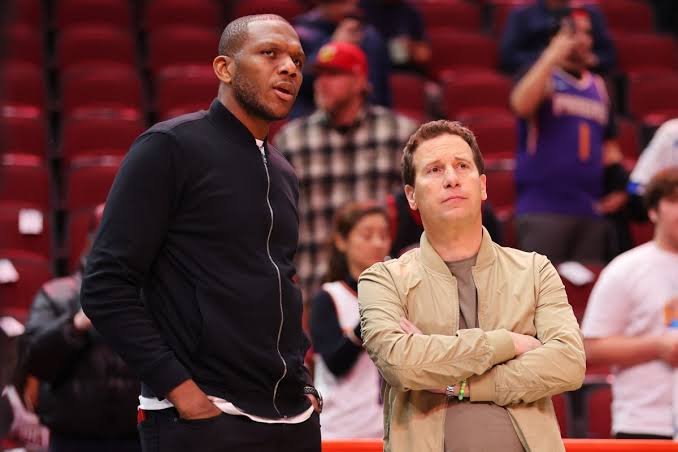Phoenix Suns Shake Up Their Front Office: A Bold Reboot Under New Ownership
In a dramatic shakeup following one of the darkest seasons in recent Suns history, team owner Mat Ishbia has made sweeping changes to the organization’s basketball leadership. These moves mark a decisive pivot in philosophy—towards youth, internal alignment, and a clearer chain of command.
What Changed?
1. James Jones transitions to Senior Advisor
After serving as both President of Basketball Operations and General Manager since 2022—and captaining the Suns to four straight playoff appearances and a trip to the 2021 NBA Finals—James Jones has been reassigned to a senior advisory role. His talents remain valued, but the leadership structure has shifted (NBA). Notably, Jones has since departed Phoenix altogether, taking on a front-office position with the NBA (Bright Side Of The Sun).
2. Brian Gregory elevated to GM
Formerly Vice President of Player Programming—a role he had only held since June 2024—Brian Gregory was named General Manager on May 1, 2025 (NBA). A longtime college coach who once mentored Ishbia at Michigan State, Gregory’s appointment signals a fresh direction, built around internal experience and a loyalty-based approach (SI). Still, some analysts have raised concerns about his lack of traditional front-office experience (Arizona Sports).
3. Additional reshuffling in support roles
Assistant GM Oronde Taliaferro and Chief Innovation Officer Paul Rivers both saw promotions and increased responsibilities. Meanwhile, coaching-side assistant GM Gerald Madkins and personnel evaluation manager David Sevush departed—a clear sign that Ishbia is aligning talent evaluation with his new philosophy (SI).
Why This Matters
A. Refocused organizational structure
Ishbia’s reconfiguration of the front office is more than a title swap—it’s an effort to inject clarity and cohesion. Gregory, Jones, and Bartelstein now have defined roles: the former oversees day-to-day decisions, the latter advises, and Bartelstein (CEO) handles the business side (Wikipedia).
B. Shifting to youth and long-term sustainability
Gregory’s early moves—such as facilitating the trade of Kevin Durant for a package including rookie Khaman Maluach, Jalen Green, Dillon Brooks, and draft compensation—underscore a pivot to youth and roster flexibility (Reuters). It’s a sign that Phoenix is transitioning from “win-now splurges” to sustainable core building.
C. High owner involvement, for better or worse
While some fans and pundits have praised the calculated strategic intent behind these moves, others remain skeptical. Concerns echo a sentiment from r/suns: “They are the impulse shoppers of the NBA…as long as Ishbia thinks he’s somehow qualified to play GM, the team will never feel like there’s a coherent plan” (Arizona Sports, Reddit).
What Comes Next?
1. Coaching overhaul
Shortly after Gregory’s hire, new head coach Jordan Ott was appointed on June 6, 2025, marking yet another leadership refresh aimed at establishing a distinct team identity (Wikipedia).
2. Roster transformation underway
The blockbuster Kevin Durant trade is only the beginning. The organization continues to explore optimizing salary cap space and developing around cornerstone Devin Booker, who reportedly had input in coaching and general manager selection .
3. Organizational identity reset
With a revamped front office, fresh coaching, and a younger roster, the Suns appear to be executing a full cultural and operational renovation—moving from star-chasing to strategic rebuilding.
Final Take
Phoenix’s front-office overhaul is a bold statement: no longer willing to gamble on big-name band-aids, owner Mat Ishbia is betting on structural clarity, unified vision, and internal alignment. Brian Gregory’s ascent to GM marks a commitment to systematic growth, even if it raises questions about experience at this level.
While fans and analysts remain divided, one thing is clear: the Suns are pursuing a new formula. Whether this gamble pays off hinges on Gregory’s ability to translate front-office coordination into on-court success. The next 12–18 months will reveal whether Phoenix’s bold reset is a stroke of genius—or just another rebuild in disguise.
